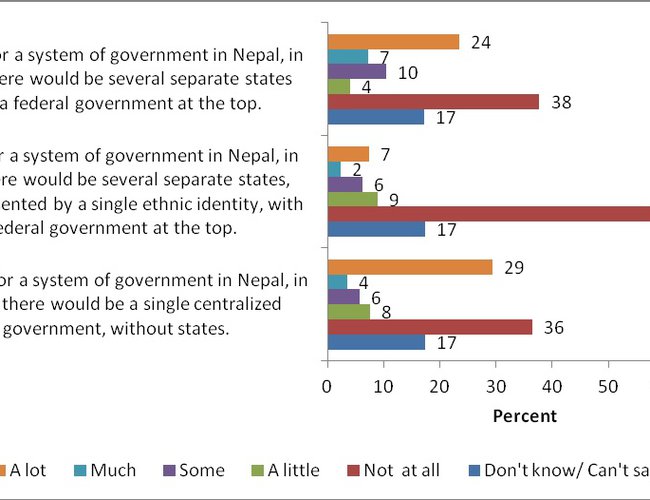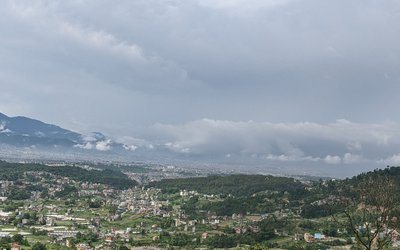
The inability of the political parties to forge an understanding on the contents of federalism was one of the main reasons they were unable to formulate a constitution through an elected constituent assembly. As political parties gear up for the next election, they will have to formulate the contents of federalism and seek validation from the public. They may also have to re-formulate or even re-think their ideas of federalism based on the feedback once they begin reaching out to their constituences.
In the months leading to the demise of the constituent assembly, three positions on federalism emerged in public discourse: support for a loosely-defined federal structure, support for a single-ethnic identity based federal states and support for a unitary state. A few months after the demise of the CA in May 2012, Interdisciplinary Analysts (IDA), a research organization based in Kathmandu, that specializes in public opinion surveys and with whom this author is affiliated with, undertook a nationwide survey, precisely to gauge the public’s opinion on this issue. The poll was undertaken over a period of 3 weeks between September 23 and October 13, 2012. A sample size of 1,500 was randomly selected from across 25 districts representing all the development and geographical regions in the country and which were in turn randomly selected from the country's 75 districts. In terms of demographic characteristics such as caste/ethnic make-up, age-groups, male-female ratio, literacy, occupational structure, religious composition, etc. the sample closely matches the census figures. The error margin of the survey is plus or minus 2.5 percent at 95 percent confidence level.
Three questions were asked, one consecutively after the other, to all the respondents to ascertain the support for their preferred system of government. The first question was "Some people have proposed a system of government in Nepal, in which there would be several separate states with a federal government at the top. To what extent would you support this system of government?" The question was framed so as to gauge support for federalism in general. The second question was "Some people have proposed a system of government in Nepal, in which there would be several separate states, each represented by a single ethnic identity, with a federal government at the top. To what extent would you support this system of government?" This question was constructed with the aim of measuring support for single-ethnic identity based states in a federal set-up. The third question was "Some people have proposed a system of government in Nepal, in which there would be a single centralized government, without states. To what extent would you support this system of government?" The third and last question was formulated to ascertain support for a unitary state or opposition to federalism of any kind. The response to these 3 questions is revealing and is clearly indicative of the preferences of the public in the federalism versus unitary state debate.
Survey data point to a great deal of opposition among the public to the creation of states based on single-ethnic identity with as high as 58 percent stating that they do not support it at all; those that say they support it are only 9 percent with 7 percent who say they support it a lot and 2 percent who say they support it much. Clearly, the system of government that has the least support among the public between the three options is a federal structure where each of the states are created on the basis of single-ethnic identity.
However, when it comes to two other choices – the support for federal state in general and the support to a unitary state without federalism – the public's preference is less clear cut and warrants a more detailed investigation.
The support for a federal government with several states i.e., loosely defined federal state, is fairly high with 31 percent stating their support with 24 percent supporting it a lot and 7 percent supporting it much. However, opposition to such a federal state is also substantial with 42 percent stating their opposition to it – with 38 percent saying thay have no support for such a state and 4 percent saying they have only a little support for it.
Likewise, support to a single unitary form of government without states is also substantial with 33 percent stating their support with 29 percent supporting it a lot and 4 percent supporting it much. However, as in the earlier case, the opposition to such a unitary state is also substantial - 44 percent are opposed to a unitary state with 36 percent saying they have no support for such a state and 8 percent saying they have only a little support for it.
What the public opinion data indicates is that while single-ethnic identity based states is equivocally rejected by the public irrespective of their caste-ethnic backgrounds (as will be illustrated later) the public seems to be divided between a loosely defined federal structure and a unitary state without federalism. This further begs the question: who are those that support federalism and who are those that oppose it?
Since much of agitation-movements that have occured in Nepal after 2006 have been according to identities that have caste-ethnic underpinnings, a dis-aggregation of the data along caste-ethnic lines offers clue as to the supporters and opponents of a federal state and a unitary state.
The table below converts the data into numbers, derives the mean support for the three options in a scale of 0 to 10 and dis-aggregates the mean support among top 20 caste-ethnic groups in the country.
|
|
Proportion of population according to the 2011 census |
Support to a system of government in Nepal, in which there would be several separate states with a federal government at the top. |
Support to a system of government in Nepal, in which there would be several separate states, each represented by a single ethnic identity, with a federal government at the top. |
Support to system of government in Nepal, in which there would be a single centralized government, without states. |
|
National Mean |
|
4.2 |
1.8 |
4.4 |
|
Chhetri |
16.6 |
3.6 |
1.1 |
5.1 |
|
Bahun |
12.1 |
3.1 |
1.1 |
5.7 |
|
Magar |
7.1 |
4.9 |
1.4 |
3.7 |
|
Tharu |
6.7 |
4.9 |
2.4 |
2.5 |
|
Tamang |
5.9 |
4.1 |
2.3 |
4.9 |
|
Newar |
4.9 |
2.3 |
0.9 |
7.2 |
|
Kami |
4.8 |
4.4 |
2 |
3.3 |
|
Muslim |
4.3 |
3.1 |
1 |
5.3 |
|
Yadav |
3.9 |
4.9 |
2.1 |
3.8 |
|
Rai |
2.3 |
4.1 |
2.8 |
4.3 |
|
Gurung |
1.9 |
5.7 |
2.3 |
3 |
|
Damai |
1.7 |
4.9 |
1.8 |
4 |
|
Thakuri |
1.6 |
4.3 |
0 |
5 |
|
Limbu |
1.4 |
6.1 |
4 |
3.7 |
|
Sarki |
1.4 |
5 |
1 |
4.7 |
|
Teli |
1.3 |
6.8 |
2.8 |
1.9 |
|
Chamar |
1.2 |
3.9 |
1.7 |
2.5 |
|
Koiri |
1.1 |
5.2 |
2.1 |
3.7 |
|
Sanyasi |
0.8 |
6 |
1 |
3.9 |
|
Kurmi |
0.8 |
5 |
1.9 |
2.5 |
The mean support for the three options - a loosely defined federal set-up, a single-ethnic identity based federal set-up and a single unitary state without federal states - in a scale of 0 to 10 is 4.2, 1.8 and 4.4 respectively. (Nationwide surveys done by IDA in the past have shown that mean average support for federalism was 4.1 in June 2011 and 4.1 in April 2012 and vouches for the reliability of scientific public opinion surveys). The data once again reveals that while the support for single-ethnic identity based federal state is extremely low, the support for a loosely-defined federal state is higher at 4.2 in a scale of 0 to 10. Nevertheless, it is still slightly lower than support for a unitary state, which stands at 4.4. However, more revealing than the national averages across these three options is how Nepal's various caste-ethnic groups tend position themselves.
Caste-ethnic dis-aggregated figures for a loosely-defined federal structure reveals a clear pattern. The average support for a federal structure is relatively high among hill janajati groups (6.1 among Limbus, 5.7 among Gurungs, 4.9 among Magars), Tarai-Madhesi ethnic groups (6.7 among Tharus) and among Madhesi castes (6.8 for Teli, 5.2 for Koiri, 5 for Kurmi, 4.9 for Yadavs).
The average support for a single-ethnic identity based state is low for all groups irrespective of their caste-ethnicity. It registers a low support even among hill and among Tarai-Madhesi ethnic groups, not to mention the Madhesi castes.
Caste-ethnicity dis-aggregated figures for support to a unitary state i.e., a single centralized government without states, too reveals a distinct pattern with support for a unitary state being exceptionally high among Newars (7.2), followed by Bahuns (5.7), Muslims (5.3) and Chettris (5.1).
Another unique feature of this opinion survey where an individual responds to all the three sets of questions is the high degree of inverse correlationship in responses. What this means is that if a particular person gives a high mean rating for federalism, this individual tends to gives a low mean rating for a unitary state and vice versa.
High degree of inverse correlationship across the three different responses among individuals, however, should not be construed to mean that there are no variations across communities. In fact communities are divided in their opinion with regard to the support for federalism or opposition to it though this is more marked among some communities (for instance among the Rais, the Tamangs, and Sarkis ) than among others. To take the example of Rais, while the mean average support for a federal state is 4.1, the mean average support for a unitary state is 4.3, which means that while some individuals in the Rai community tend to support a federal state, others tend to support a unitary state.
Chettri and Bahun orientation on this issue is of utmost importance for two reasons. First these two communites clearly constitute the two largest communities in Nepal – while Chettris make up 16.6 percent of the population, Bahuns make up 12.1 percent of the total population according to the 2011 census. Second, these caste groups constitute the youngest identity movements being formed as recently as 3-4 years back and happen to be rapidly expanding their organizational structures and activities across the country.
The CA was dissolved due to the inability of political parties to reach an understanding on federalism, a phenomenon that was made more complex by the identity movements espousing their own varients of the federal state or their opposition to federalsim altogether in the days leading to the demise of the CA. This issue could continue to polarize parties and people in the days to come. The obvious dilemma facing the political parties is loosing hill janajati, Tarai-Madhesi janajati and Madhesi votes if they abandon federalism or loosing Chettri and Bahun votes if they favour a strong federal state. On the face of it, striking a compromise appears to be untenable.
Political opinion polls, however, do suggest a way out for overcoming the dilemma. When asked what they anticipate with the implementation of federalism, though negative associations such as "Nepali state will disintegrate", "Nepal will be weakened", "various caste-ethnic groups will begin fighting against one another" predominate - and this is something that the political parties will have to work upon seriously; the positive associations point to what the people really expect from federalism – "more and stronger development at the local level", "not having to go to Kathmandu for small things" and "employment opportunities for all living in the state".















